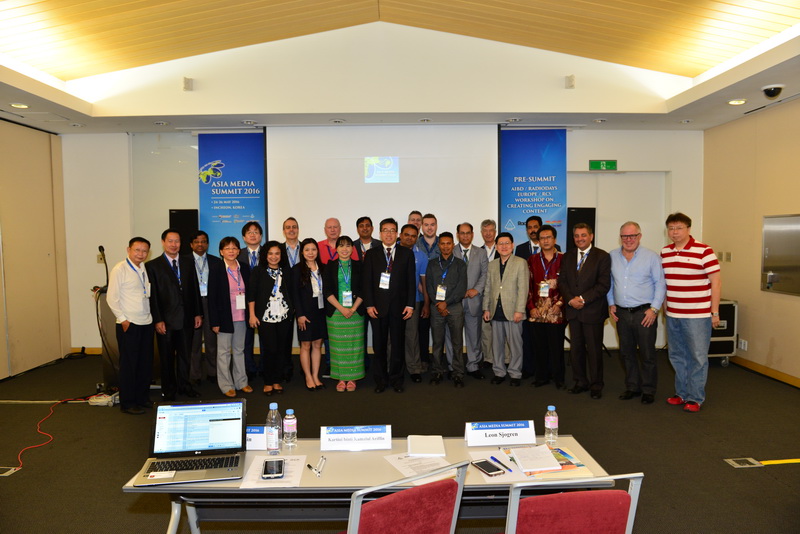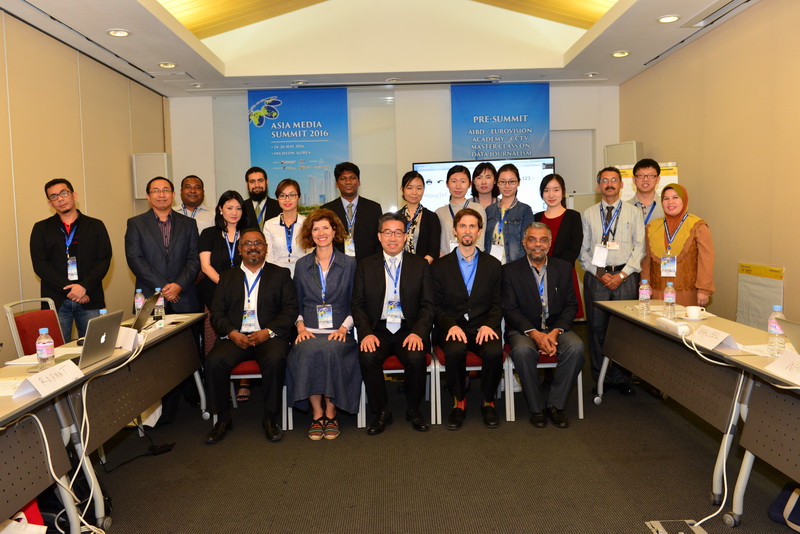Radio stations in developing countries are missing opportunities in making their content live after they’ve broadcast it. They must learn to broaden their audience “by making the most of their content – getting more listeners, more revenues and more exposure for their brand.”
Mr. James Cridland, a Radio Futurologist from the UK, gave this advice to broadcasters who participated in the presummit Workshop on ‘Creating Engaging Radio Content’ held Monday in Incheon, South Korea.
Radio stations in developing countries are missing opportunities in making their content live after they’ve broadcast it. They must learn to broaden their audience “by making the most of their content – getting more listeners, more revenues and more exposure for their brand.”
Mr. James Cridland, a Radio Futurologist from the UK, gave this advice to broadcasters who participated in the presummit Workshop on ‘Creating Engaging Radio Content’ held Monday in Incheon, South Korea.
In his presentation, Mr. Cridland identified five areas where radio broadcasters can make the most of their content. First, once put on air, broadcast of content must be repeated in various segments and in different ways.
Second, when radio broadcasters come out with good interviews, they must transcribe content and offer them to newspapers, websites and other media platforms that can use them for publication. They must ensure they get proper credit for sharing their content.
Third, radio broadcasters must recognise the benefits of setting up an archive where they can keep things for storage and future use.
“When a news event like the death of a celebrity takes place, a station can retrieve from its archive past interviews with that person and rebroadcast it. This enhances reporting of the story,” Cridland said.
Fourth, use social media to broaden the reach of the radio station, generate more exposure of the radio’s brand and possibly increase revenues for the company.
And fifth, be aware of how audio, videos and other media texts are being used to make content in a multiplatform world and tap them for their own benefit.
In his work at Virgin Radio in the UK, Cridland said they followed these guidelines and gained an additional 25% increase in audience reach in making the most of its content.
The one-day workshop also featured other speakers like Mr Leon Sjogren, Executive Producer, Triple M, SCA, Australia, who spoke on developing radio content relevant to its audiences, and Won Sup Shin, Senior Producer, Radio Department, Korean Broadcasting System, who shared the KBS experiment with new formats in designing content based on audience research.
Other speakers were Steve Ahern, Broadcasting Consultant from Australia, who gave an overview of the newest trends in successful radio formats in Asia Pacific, and Ms Kartini bent Kamalul Griffin, Director of Radio, iM4U FM, Malaysia, who spoke about his station’s key success as a vibrant youth channel.
AIBD organised the workshop with support from Radio Days Europe and RCS.
Making the Most of Radio Content
Radio stations in developing countries are missing opportunities in making their content live after they’ve broadcast it. They must learn to broaden their audience “by making the most of their content - getting more listeners, more revenues and more exposure for their brand.” Mr. James Cridland, a Radio Futurologist from the UK, gave this advice to broadcasters who participated in the presummit Workshop on ‘Creating Engaging Radio Content’ held Monday in Incheon, South Korea.
New Ways to Tell Compelling Stories through Data Journalism
News organisations across the globe are increasingly using data journalism to find new and compelling ways of telling stories with numbers and infographics, and make people more engaged with information. “Data journalism is making the journalism field more exciting and vibrant,” Mr Kevin Anderson, Faculty member of EBU’s Eurovision Training Academy, told participants of the AIBD/Eurovision/CCTV Master Class on Data Journalism held Monday in Incheon, South Korea.
AIBD’s Future Plans
AIBD Director Chang Jin shared Monday some of AIBD’s future plans in his message to participants in the presummit event on ‘Drones for Content Production,’ citing new initiatives to better serve the Institute’s members and partners.
“We will continue to grow and sustain the Asia Media Summit, now on its 13th year. We will expand participation in this premier communication event not only from the broadcast media industry, but also from new media,” he said.
Steps for a Successful Social Media Community
Setting goals, creating realistic plans and strategies, defining the audience and platform to use to meet your objectives, and determining how to measure results are critical requirements for success in creating a vibrant social media community.
“ You cannot engage effectively in social media without these steps; otherwise your efforts will lead to failure,” said Mr. Benjamin Dalmulder,, Team Manager for Digital Analytics and Search Engine Optimisation, and Ms Katarina Gomes, digital strategist, both of RNW Netherlands, during the regional Workshop on Online and Social Media Analytics held Monday in Incheon, South Korea. Both served as consultant for the project organised by AIBD and supported by RNW, Netherlands.
Popularising Drones for News and Dramas
The use of drones or unmanned aerial vehicles (UAV) is increasingly becoming popular for content production on various media platforms. Drones have changed the ‘shooting environments’ in news and drama production, enriching content and viewers’ satisfaction. More broadcast stations are also beefing up their in-house capabilities for drone services.
These are some of the trends in content production that Mr James Ku, President of James Company Ltd,. Korea, highlighted in his presentation Monday during the workshop on ‘Using Drones for Production; A New Wave in Broadcast Content Production,” one of the five –pre-summit events leading to the Asia Media Summit to be held tomorrow in Inchon, Korea.Exhilarating Excursion for all AMS 2016 Delegates
Delegates are in for an exciting time with the official
World TV Awards – Jury Session
The final jury session of the World TV Awards 2016 took place 28 and 29 April 2019 at the AIBD office in Kuala Lumpur, Malaysia. The first day was dedicated to the Humanity Award selection, following the next day by the Science/Environment category.
AIBD Mobile Apps
Exhilarating Excursion for all AMS 2016 Delegates
Delegates are in for an exciting time with the official
AIBD Announces The Golden Bridge Awards on Intercultural Understanding
AIBD is pleased to announce its new initiative --- the




